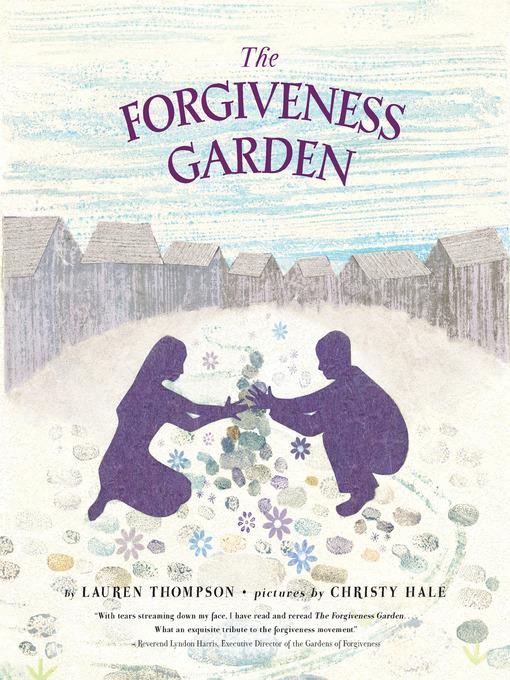
The Forgiveness Garden
فرمت کتاب
ebook
تاریخ انتشار
2012
Lexile Score
480
Reading Level
0-2
ATOS
3
Interest Level
K-3(LG)
نویسنده
Christy Haleناشر
Feiwel & Friendsشابک
9781466818323
کتاب های مرتبط
- اطلاعات
- نقد و بررسی
- دیدگاه کاربران
نقد و بررسی

October 8, 2012
Two fictional warring villages, Vayam and Gamte, sit across a stream from each other. When a Gamte boy named Karune throws a rock and injures a Vayam girl, revenge is expected. But the girl, Sama, forgives her attacker and uses rocks to begin building a garden the two communities can share. Thompson’s (the Little Quack series) allegorical tale, inspired by a real Garden of Forgiveness in Lebanon and an educational movement of the same name, comes to life in Hale’s (The East-West House) stylized collages. The browns, grays, and fiery pinks of the initial pages give way to softer pastels; the final spread shows Sama and Karune in silhouette sitting on the garden wall, surrounded by flowers. The closing sentence, “What do you think they said?” offers a good jumping-off place for discussions about conflict. The distinct people and place names have their origin in ancient Sanskrit; e.g., Sama derives from the word for forgiveness. A concise, potent read that imparts the message that violence need not result in more of the same and that it only takes one person to effect that change. Ages 4–6.

September 15, 2012
Two villages separated by a stream and a history of anger wonder if they will ever stop fighting. Cleverly based on the Sanskrit words for "us" and "them" the two fictional villages of Vayam and Gamte have hated each other for a long time. One day, during a particularly violent argument, a Gamte boy named Karune throws a large stone across the stream and hits a Vayam girl named Sama on the head. The Gamte side cheers, while the Vayam side plots revenge. Karune is held captive, and the villagers give Sama the same large stone to hurl back at him. But Sama can't do it. Instead, she places the stone on the ground and suggests they use it to build a garden wall. She calls it a forgiveness garden. Peace isn't restored instantaneously; there are still many questions: "If we forgive, must we forget all that has happened?" "Must we apologize?" True to life, there are no definitive answers--just simply sit in the garden and find out. Hale's textured collages contain commonplace landscapes and silhouetted crowds, cloaking this parable in anonymity. An afterword by the Rev. Lyndon Harris explains the real Garden of Forgiveness in Beirut, Lebanon. There are many possible paths to peace, but learning forgiveness is essential to all of them, as this book demonstrates. (Picture book. 5-8)
COPYRIGHT(2012) Kirkus Reviews, ALL RIGHTS RESERVED.

November 1, 2012
Gr 2-4-This parable is based on the Garden of Forgiveness in Beirut, planted in the aftermath of the Lebanese civil war. In a valley divided by a stream, the villagers on both sides have hated one another for as long as they can remember. When a new argument arises, a Gamte boy throws a large stone across the stream and strikes a Vayam girl, leading to calls for revenge. The people on both sides are angry, fearful, and sad, and they wonder if the fighting will ever end. It is the girl, Sama, who looks at her scarred and scowling reflection and, glancing across the water at the scared and angry children on the other side, thinks, "They are just like us." She is handed a stone with which to exact her revenge against the boy, Karune, but she flings it to the ground, suggesting that stones should be used to build a "forgiveness garden" instead. Slowly a garden wall is built, but the people have questions: "If we forgive, must we forget all that has happened?" "Will [they] apologize?" When the garden is complete, Sama and Karune sit together and talk. The text ends with, "What do you think they said?" A story such as this risks being overly didactic, but the message here is softened and enhanced by the full-bleed, mutely toned collage illustrations. Richly textured in a palette of muddy browns, sandy beiges, soft blues, and healing violet, the images are simple yet powerful. This is a thought-provoking gateway into discussions about conflict, war, and, most importantly, the ability of willing souls to strive for reconciliation and forgiveness.-Teri Markson, Los Angeles Public Library
Copyright 2012 School Library Journal, LLC Used with permission.

November 1, 2012
Grades K-3 Inspired by the real Garden of Forgiveness that was built in Beirut after the Lebanese Civil War that ended in 1990, this parable tells of two neighboring villages that have long been in conflict with each other. The striking collage artwork in muted tones shows silhouetted figures hurling stones at their neighbors across a river. Then the story's focus narrows to two young people. A boy, Karune, hurls a stone that hits Sama, a girl across the water, hard on the head, and she falls to the ground. The incident sparks both communities to call for revenge, and the hatred grows. But after Sama's people capture Karune and tell her to throw a stone at him, she refuses. Let us build a garden, she says, and people from both sides agree, even Karune. A final scene shows the young people together in the blossoming garden. The purposeful messages are balanced by the personal story that shows how difficult it can be to create peace, and the afterword will help kids connect news headlines with their own schoolyard standoffs.(Reprinted with permission of Booklist, copyright 2012, American Library Association.)

























دیدگاه کاربران